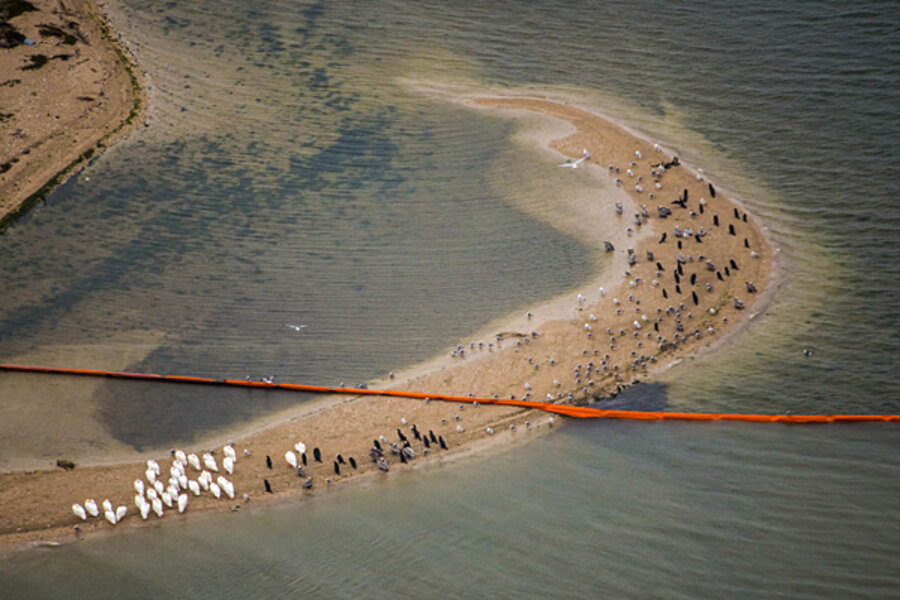Galveston oil spill: Does oil boom mean more spills?
Loading...
A Galveston oil spill sent 168,000 gallons of a heavy marine fuel oil into a busy Texan waterway after a barge collided with a ship Saturday. The 50-mile Houston Ship Channel in Galveston Bay remained closed early Monday, as crews worked to contain an oil spill that experts said would be particularly difficult to clean up.
Saturday's spill poses a significant threat to local wildlife and jams up a major shipping route vital to the region's economy. It came days ahead of the 25th anniversary of the Exxon Valdez disaster, which spilled 11 million gallons and still leaves its mark on Alaska's Prince William Sound.
Oil barge safety has improved dramatically in recent decades, but a sharp uptick in US oil production has raised new concerns about how to safely transport the fossil fuel. The exact cause of Saturday's Galveston oil spill remains to be determined, but the collision draws attention to increased oil tanker traffic in the nation's waterways and the environmental toll it can take.
“Fuel oil is not easy to clean off anything,” said Jim Suydam, a spokesman for Texas' General Land Office, a state agency leading the response in conjunction with the US Coast Guard, told The Texas Tribune. “It sticks to things.”
There were three major oil spills (5,000 barrels of oil or more) from tankers worldwide in 2013, according to the International Tanker Owners Pollution Federation, a London-based nonprofit organization of tanker owners. That's an increase from zero the year before and one in 2011, but reflects an overall downward trend from the average of 25 major spills per year in the 1970s.
The largest ship-based oil spill occurred when two fully loaded tankers collided in the West Indies in 1979 spilling 2.1 million barrels of crude oil. By comparison, Exxon Valdez spilled 260,000 barrels of oil, making it the largest ship-based oil spill in the US. The largest US oil spill came not from a ship but from a drilling platform in the 2010 BP oil spill in the Gulf of Mexico, which spilled nearly 5 million barrels of oil.
More durable and maneuverable ships have made transporting oil by tanker and barge safer, according to the American Petroleum Institute, an industry association. Modern tankers are built with a hull-within-hull design that protect contents from external impacts. Also, route adjustments can be made with a single operator through a central, electronic command station (as opposed to analog adjustments made by disparate crew members). Duplicate rudders, GPS systems, and propellers have also made it easier for captains to navigate obstacles.
Even with added safety measures, tanker traffic is on the rise as increased oil production has overwhelmed the nation's pipeline infrastructure. Tankers and barges moved 70 million barrels of crude oil and petroleum products from the Midwest (including newly oil-rich North Dakota) to the Gulf Coast in 2013, according to the US Energy Information Administration. That's more than double what was shipped in 2008.
Companies have also turned increasingly to rail as a means for transporting oil. In 2013, US trains transported around 400,000 carloads of crude oil, up from 9,500 carloads in 2008, according to the Association of American Railroads (AAR). A spate of oil train accidents earlier this year and in late 2012 raised scrutiny over the safety of transporting crude by rail.
Environmental groups have criticized the oil and gas industry for lax safety measures and have called for policies that promote a rapid transition to cleaner, safer, renewable energy sources.
“The impacts of oil spills continue long after the TV cameras have gone home," Larry Schweiger, president and chief executive of the National Wildlife Federation, said in a statement responding to Saturday's Galveston oil spill. "We can make sure that nothing like this ever happens again by holding polluters fully accountable today and moving the country quickly towards cleaner sources of energy for tomorrow.”








